RICHMOND BOROUGH’S STARRING ROLE IN GEORGE CLOONEY’S HOLLYWOOD FILM
PHOTO SPECIAL
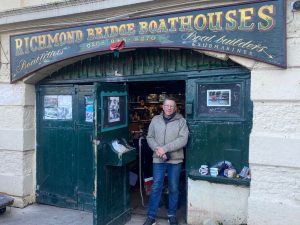
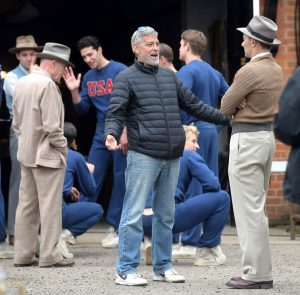
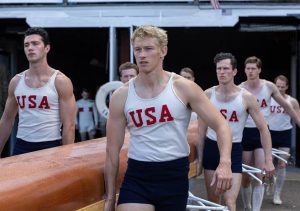
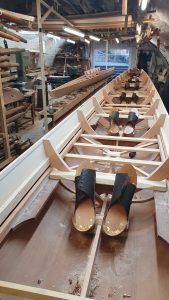
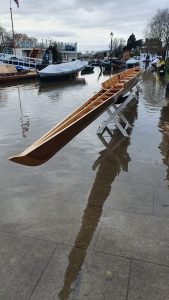
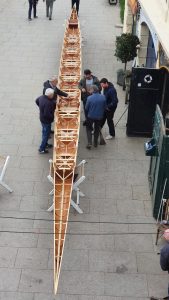
The Borough of Richmond played a key role in the making of George Clooney’s Hollywood film, The Boys in the Boat, it can now be revealed.
The actual boats featured in the film were built by master boat builder Mark Edwards MBE from his Bridge Boathouse workshops underneath Richmond Bridge.
Mr Edwards received his gong form the late Queen in recognition of his work building the GLORIANA rowbarge which played a leading part in Queen Elizabeth’s Diamond Jubilee celebrations in 2012.
His brilliant craftsmanship and the work of his small team has remained a secret until now because of confidentiality clauses in contracts between him and the film makers. The film went on general release two weeks ago.
The film recreates the true of an unlikely bunch of young men thrown together at the University of Washington who learn to row together and, against all the odds win the Gold medal at Hitler’s 1936 Olympics in Berlin.
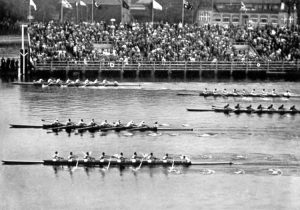
The main boat, an eight-oar 60ft wooden boat called the Husky Clipper was built in the workshop with a second identical one built in case of a serious mishap during filming.
It was just another job for 69 year old Mark when Hollywood came knocking but a job which required perfect craftsmanship for the up- close camera shots as well as reliability, sturdiness and speed for the boat to survive the rigours of countless hours of filming on the River Thames and at various locations like Molesey Rowing Club near Hampton Court, Henley and Cotswold Water Park.
The racing shell was assembled in the tool-rammed backroom workshop in Richmond using computer-generated drawings from the original boat, which was built by legendary boat builder George Pocock, who had moved to Vancouver from Kingston upon Thames in 1911.
Mark also built a practice boat or training punt called Old Nero with sixteen oars and a double plank down the middle which features in the film and now acts as a landing stage in front of his workshop under Richmond Bridge.
WATCH THE TRAILER HERE:
https://www.google.com/search?q=boys+in+the+boat+trailer&rlz=1C1CHBF_en-GBGB1005GB1005&oq=boys+in+the+boat+tra&gs_lcrp=EgZjaHJvbWUqBwgAEAAYgAQyBwgAEAAYgAQyBggBEEUYOTIHCAIQABiABDINCAMQABiGAxiABBiKBTINCAQQABiGAxiABBiKBagCALACAA&sourceid=chrome&ie=UTF-8
“I persuaded the film people to let us build a second identical boat because there was obviously a risk the first one could be crunched during the filming, which would be a massive setback,” Mark told Teddington Town in his first interview as he planned his big outing to see the film for the first time at the Odeon Cinema in Richmond and a celebration drink afterwards at The Old Ship pub nearby.
The replica boat was built in two separate parts, two thirds of the length and then one third and then joined together to avoid massive pressure in the middle of the full length of the boat as it was constructed. A massive and intricate structure of wooden ‘ribs’ support the red cedar skin.
Mark got the go ahead and contract to build the boat with his veteran and world famous traditional wooden boat builder friend Bill Colley, aged 85 after a meeting with the US executive producer Barbara Hall at another nearby boat workshop along the foreshore in Richmond.
“We told Barbara we had worked in the film business and were very experienced in boat building and she realised we could do it and in the end we did it on time and ahead of budget, which she really appreciated and she said was very unusual!”
The partnership with Bill was vital because he had started out as an apprentice racing boat builder and knew the ropes and offered the expertise and wise counsel for the three month building project, which started in September (or December 2021)
The ‘shell’ itself is built upside down with a ‘tortured’ marine plywood hull made of carefully selected veneers and a skin specially made of special red cedar is stretched across the entire frame of the boat and it’s all held together with glue and several thousand small copper nails.
Mark, who received his MBE for boat building services and specifically the building of Queen Elizabeth’s Gloriana, led his team on the building with a young Albanian colleague Luan Qeloposhi and an engineer friend John Hodges and Richard Bennett.
A total of 120 oars, each 12ft long were provided by the famous mast and oar makers, 85 year old Collars of Dorchester on Thames, Oxfordshire in another triumph for traditional British craftsmen.
They were made from scratch with North American spruce as part of a five month production line and are tubular with specially hand-crafted leather attachments.
Unbeknown to passers-by in Richmond the finished version of the main boat Husky Clipper could be first seen afloat – not in the River Thames just a stone’s throw away – but on the foreshore of Mark’s workshop during a high-tide flood.
Mark started out working in a boat hire and repair business in Richmond when he was just 15 and acquired ‘an affinity to the water’ learning to ‘punt’ with his father in nearby Hampton.
“I fell in love with the river and boat building,” he says. “I did an apprenticeship and I had the blarney to deal with people and I was practical. I could repair a skiff with a mate in my early teens.”
As a pupil at Thames Valley Grammar school, he made it clear to his masters that he had ‘no interest whatsoever’ in playing rugby on Wednesday afternoons and was, instead, granted special permission to go rowing on the nearby Thames with a few similarly-minded classmates.
Later he worked with ex-Royal Navy shipwright called Fred Coppard in the Stockyard at Bushy Park where he learned the craft of boat building. “That taught me a really valuable lesson, never to be frightened of any project. It was material science and if you understood the materials whether it was timber, glass or metal, you can’t go wrong.
“I am very proud that I am handing on the baton of building traditional wooden boats to the next generation, training youngsters how to run a job. I don’t seek any acclaim for myself but it does give me tremendous pleasure that I am keeping boat building alive for many years to come.”


